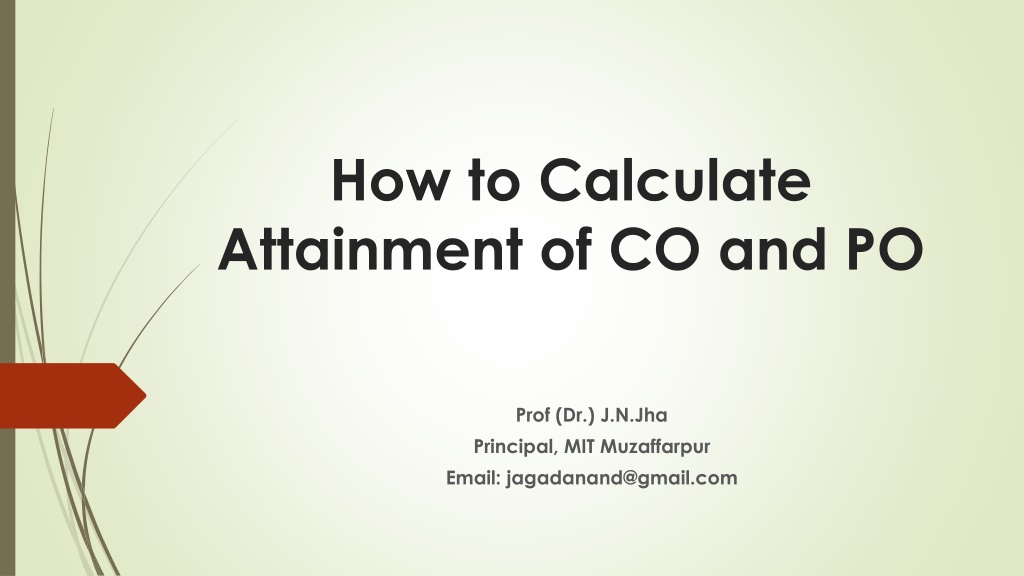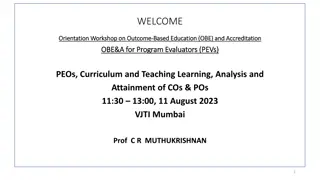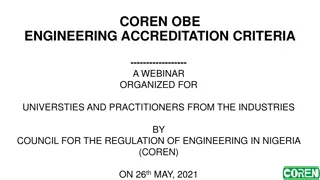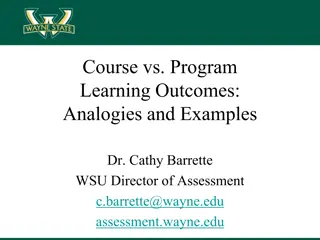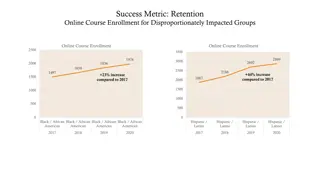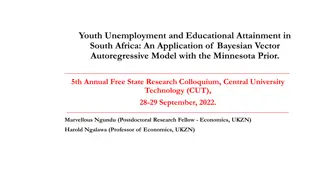Understanding Course Outcomes and Program Attainment in Engineering Education
Graduates of engineering programs in India are required to attain Program Outcomes (POs) identified by the National Board of Accreditation (NBA) through courses, projects, and activities. Course Outcomes (COs) define what students should be able to do at the end of a course and play a crucial role in assessing students' performance. This process involves aligning instructional activities, assessments, and course outcomes to facilitate effective learning. CO statements include actions, cognitive processes, knowledge categories, conditions, and criteria to ensure a clear and measurable understanding of student achievements in engineering education.
Download Presentation

Please find below an Image/Link to download the presentation.
The content on the website is provided AS IS for your information and personal use only. It may not be sold, licensed, or shared on other websites without obtaining consent from the author. Download presentation by click this link. If you encounter any issues during the download, it is possible that the publisher has removed the file from their server.
E N D
Presentation Transcript
How to Calculate Attainment of CO and PO Prof (Dr.) J.N.Jha Principal, MIT Muzaffarpur Email: jagadanand@gmail.com
Engineering Programs Graduates of Engineering Programs in India are required To attain the Program Outcomes (POs) identified by the National Board of Accreditation (NBA) To attain Program Specific Outcomes (PSOs) identified by the University or the Department offering the Program. POs and PSOs are to attained through courses, projects, co-curricular and extra-curricular activities (in which performance of the students is evaluated).
Courses Courses are broadly classified Core courses and Electives. Core courses are Classified Engineering/Engineering Science, and Basic Sciences / Humanities / Social Sciences /Management POs and PSOs are to be attained through core courses, project and activities (in which all students Participate- Elective will not be considered). Courses constitute the dominant part of any engineering program.
Students learn well Course Outcome when they are clear about what they should be able to do at the end of a course (Course Outcomes) Assessment is in alignment with what they are expected to do (Assessment in alignment with Course Outcomes) Instructional activities are designed and conducted to facilitate them to acquire and demonstrate what they are expected to do (Alignment among Instruction, Assessment and Course Outcomes)
What are Course Outcomes? Course Outcomes (COs): What the student should be able to do at the end of a course It is an effective ability, including attributes, skills and knowledge to successfully carry out the identified activity Most important aspect of a CO: Should be observable and measurable
Structure of a CO statement Action: Represents a cognitive/ affective/ psychomotor activity the learner should perform. An action is indicated by an action verb, occasionally two, representing the concerned cognitive process(es). Cognitive Process Evaluate, Create (Action Verb): Remember, Understand, Apply, Analyze, Knowledge: Represents the specific knowledge from any one or more of the eight knowledge categories Factual, Conceptual, Procedural, Metacognitive, Fundamental Design Principles, Criteria & Specifications, Practical Constraints, Design instrumentalities Condition: Represents the process the learner is expected to follow or the condition under which to perform the action (This is an optional element of CO) Criteria: Represent the parameters that characterize the acceptability levels of performing the action (This is an optional element of CO)
Two Action Verbs Some times it becomes equally important for a student to perform two cognitive processes/sub-processes on given knowledge elements. Only in such cases, two action verbs are used in a CO statement-Don t combine two COs into one Example Draw Bode plots for the given dynamic system and determine the gain and phase margins Drawing and determining are equally important and both processes are related to the same knowledge elements of Bode plots
Sample 1- CO statement Calculate major and minor losses associated with fluid flow in piping networks Action: Calculate (Apply) Knowledge: major and minor losses associated with fluid flow in piping networks (Conceptual and Procedural) Condition: None Criteria: None
Sample 2- CO statement Determine the dynamic unbalanced conditions of a given mechanical system of rigid bodies subjected to force and acceleration Action: Determine (Apply) Knowledge: Dynamic unbalanced conditions (Conceptual and Procedural) Condition: given mechanical system of rigid bodies subjected to force and acceleration Criterion: None
Sample 3- CO statement Understand the effect of all the parameters in voltage controlled oscillators through simulation using TINATI. Action: Understand Knowledge: effect of all the parameters in voltage controlled oscillators (Conceptual) Condition: using simulation using TINATI Criterion: None
Sample 4- CO statement Determine the root of the given equation, accurate to second decimal place, using Newton-Raphson method Action: Determine (Apply) Knowledge: root of the given equation (Conceptual and Procedural) Condition: using Newton-Raphson method Criterion: accurate to second decimal place
Number of COs for a Course Too small a number of COs do not capture the course in sufficient detail and may not serve instruction design that well. Too many COs make all the processes related to assessment design and computation of attainment of COs messy and demanding. A 3:0:0, 3:1:0 and 3:0:1 courses should have about 6 course outcomes. The number of COs of courses carrying different number of credits can be suitably adjusted
Dos and Donts Use only one action verb Do not use words including like , such as , different , various etc. with respect to knowledge elements. Enumerate all the relevant knowledge elements. Put in effort to make the CO statement as detailed as possible, and measurable. Do not make it either too abstract or too specific
Check List Does the CO begin with an action verb? Is the CO stated in terms of student performance (rather than teacher performance or course content to be covered)? Is the CO stated as a learning product rather than as a learning process? Is the CO stated at the proper level of generality, and relatively independent of other COs? Is the CO attainable in the given context (students background, prerequisite competences, facilities, time available and so on)?
Acceptability of COs Students will execute mini projects Instructional activities are designed to facilitate the attainment of COs by learners, but themselves are not COs Have the concepts of compensators and controllers (P, PD, PI, PID) COs are competencies / behaviors that can be demonstrated; not descriptions of internal changes in the students (though these are necessary) Optimal Generator scheduling for thermal power plants by using software package in the lab No action verb; no way of assessing; no way of determining attainment level; syllabus part is rewritten.
Acceptability of Cos Cont. Will get knowledge of protection schemes for Generator, Transformer and Induction Motor COs are competencies / behaviors that can be demonstrated; not descriptions of internal changes in the students (though these are necessary) Apply problem solving techniques to find solutions to problems. Too general; no clear way of assessing! Study variety of advanced abstract data type (ADT) and data structures and their Implementations Activity that the student engages in during the Course; not what he / she becomes capable of demonstrating at the end of the course; the word variety is not to be used. Know the stress strain relation for a body subjected to loading within elastic limit. Internal change; Not an action that can be demonstrated
Acceptability of Cos Cont. Students will be able to learn the structure, properties and applications of modern metallic materials, smart materials non-metallic materials and advanced structural ceramics. An outcome? How to assess? Students will be aware of base band signal concepts and different equalizers. Internal change; Not an action that can be demonstrated Get complete knowledge regarding adaptive systems Not an action that can be demonstrated; Internal change; Too ambitious to be realistic?
Tagging of Course Outcomes Tag Course Outcomes POs, PSOs, Cognitive Levels, Knowledge Categories addressed, Number of classroom/ laboratory/ field sessions associated with the COs
Tagging of Course OutcomesCont. Tagging COs with Classroom Sessions-Different COs may have different number of classroom sessions Tagging COs with Cognitive Levels-CO statement starts with an action verb from one of the cognitive levels (R-Remember, U-Understand, Ap- Apply, An-Analyse, E-Evaluate and C- Create) Tagging COs with Knowledge Categories-CO statement includes one or more categories of knowledge
Tagging COs with PSOs/POs- Concern/Grey areas All the COs of a course typically address the same PSO(s). Majority of the courses (non-autonomous institutions): Don t address strongly any PO other than PO1 PO1: Engineering Knowledge Possible that PO2, PO3, PO4, PO5 are addressed slightly by some courses. PO2: Problem Analysis PO3: Design/Development of Solutions PO4: Conduct Investigations of Complex Problems PO5: Modern Tool Usage Hardly any course addresses complex engineering problems
Tagging COs with POs- Concern/Grey areas Some specific courses address PO7, PO8, PO9, PO10 and PO11 PO7: Environment and Sustainability PO8: Ethics PO9: Individual and Teamwork PO10: Communication PO11: Project Management and Finance Projects can potentially address many Pos, (Rubrics-used to evaluate) Department can arrange for some activities outside the curriculum to address some POs PO6: The Engineer and Society PO12: Life-Long Learning
Course Outcome POs/ PSOs CL KC Class Session s CO1 Understand the fundamentals of fluid mechanics and fluids PO1, PSO1 PO1, PSO1 PO1, PSO1 U C, 6 CO2 Determine the basic equation to find the force on submerged surfaces CO3 Calculate the center of buoyancy of floating body, and the, velocity and acceleration of a fluid Ap C, P 9 Ap C, 12 CO4 Calculate flow parameters using fluid flow meters and using dimension analysis to predict flow phenomena, viscous effects using Hagen Poiseille s equation PO1, PSO1 Ap C, P 12 CO5 Calculate functional losses through pipes and to calculate the drag and life, displacement, momentum and energy thickness PO1, PSO1 Ap C, P 12 Total hour of Instruction Fluid Mechanics - Credits: 4:0:0 Cognitive Level (CL), Knowledge Categories (KC), 54
Attainment of Course Outcomes- CO Attainment and Quality Loop
Setting CO Attainment Targets Same target (all the COs of a course) class average marks > 60 marks Targets set in terms of performance levels of different groups of students. (does not provide any specific clues to plans for improvement of quality of learning) Targets (% of students getting) (< 50) (>50 and < 65) (>65 and < 80) ( 80) 10 40 40 10
CO Target (Class Average %) 70 Targets are set for each CO of a course separately CO1 Does not directly indicate the distribution of performance among the students CO2 80 Advantage of finding out the difficulty of specific Cos CO3 75 Improvements also can be planned CO-wise CO4 65 CO5 70 CO6 80
Attainment of COs Attainment of COs can be measured directly and indirectly Direct attainment of COs can be determined from the performances of students in all the relevant assessment instruments. The exit survey form should permit receiving feedback from students on all the COs. Computation of indirect attainment of COs is based on the perceptions of students! Hence, the percentage weightage to indirect attainment can be kept at a low value, say 10%.
Direct CO Attainment Direct attainment of COs is determined from the performances of students in Continuous Internal Evaluation (CIE) and Semester End Examination (SEE). The proportional weightages of CIE: SEE will be as per the academic regulations in force Proportions of 20:80, 25:75, 30:70, 40:60, 50:50 are all possible! Direct attainment of a specific COs is determined from the performances of students to all the assessment items related to that particular CO. Also, we need data about performance of students, assessment item-wise
Direct CO attainment from CIE and SEE Continuous Internal Evaluation (CIE) is conducted and evaluated by the Department itself in both Tier 1 and Tier 2 institutes. When questions are tagged with relevant COs, the department has access to performances of students with respect to each CO. Hence, computing the direct attainment of COs from CIE is straight forward for both Tier 1 and Tier 2 institutes. Semester End Examination (SEE) is conducted by the University for Tier 2 institutes No means of computing the direct attainment of individual COs from SEE! Only possible solution, though not satisfactory, is to treat the average marks in SEE as the common attainment of all COs!!!
Assessment Plan for CIE - Tier 2 College (Sample Assessment Plan for CIE) Total Marks for CIE: 25 (A1: Assignment 1; T1: Test 1; T2: Test 2)
